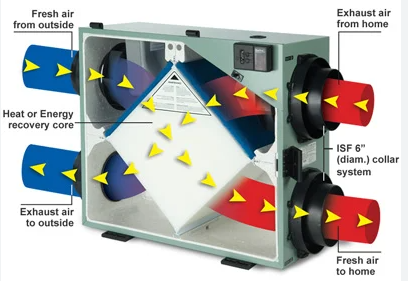High Humidity in a Pole Barn Home
Reader SAM writes: “I had a pole barn home built before pole barn homes became so popular. A concrete floor was poured around the 6×6 posts, and wooden trusses make up the roof. The pole barn walls have 2×6 purlins, and the roof has 2×4 purlins. Fiberglass insulation with a plastic vapor barrier sandwiched between the metal and the purlins. The vapor barrier is facing inside the structure, and the fiberglass is against the metal. I had living quarters framed inside the pole barn. The living structure is typical house construction with 2×4 walls, bat insulation in the walls, drywall, and cellulose blown over the ceiling joist of the living space. The living space has an HVAC with the air handler installed above the living space mounted between the trusses. When the structure was first built, the builder did not allow for any roof ventilation and no overhang or soffit vents to bring in fresh air. We started having high humidity inside the living space, even with the HVAC. Over the years, I had several HVAC companies evaluate the problem, and no one could give me an answer or solution to the problem. I removed a strip of the insulation and vapor barrier along the ridge cap and at the gable ends of the barn. I installed a vented ridge cap and used a cor-a-vent type vent installed under the gable rakes to provide ventilation up the gable walls and into the barn. I am considering installing another cor-a-vent product under the fascia along the walls to allow more airflow into the pole barn and attic space along the barn’s length. The concrete slab never appears wet on the garage side of the barn. Also, I have never noticed the flooring inside the living space being wet or damp. Do you have any ideas on why I am having the high humidity in the living space and what I can do to correct the problem?”
First why….
Everyday activities like cooking, washing, and showering can contribute to humidity levels.
Humidity levels can be affected by simple activities taking place in a household every day. These tasks can naturally add more moisture to air. Cooking and running a dishwasher can add more water vapor to kitchen air. Long, hot showers add a lot of moisture to bathrooms. Keeping areas ventilated by opening a window or installing an exhaust fan can lower humidity inside. Certain appliances, such as clothes dryers and stoves, need to vent to outside. A whole-house dehumidifier can also help eliminate some moisture created by these activities.
Leaks coming through cracks in plumbing system.
An interior plumbing leak from a bathroom or kitchen sink can cause increased moisture. Check pipes for cracks and corrosion.
Moisture from soil under your concrete slab.
If there is not a vapor barrier under your concrete slab, this can be a major source of moisture. This is called rising damp. Ineffective grading can be a significant factor since groundwater and rain can accumulate under your home. Gutters and downspouts should direct outflow at least 10 feet away from exterior walls. Ground outside your building should slope away at least six inches in 10 feet.
Your AC unit may be too big for your home.
Bigger isn’t always better: An oversize central AC unit may be reason for excessive moisture in a home. Evaporator coils found inside AC units act as a dehumidifier and pulls humidity from the as it runs. However, if a unit is too large, it may cool a room or home too quickly, running for only 10 to 15 minutes on a hot day before it abruptly shuts down. This is commonly referred to as short cycling. A longer runtime is needed to dehumidify a home correctly.

And then your likely solution:
I am surprised none of your HVAC professionals have recommended an ERV (Energy Recovery Ventilator). An ERV system will keep your indoor relative humidity at a desirable level.






